创业者人力资本与社会网络对创业机会识别影响研究
VIP免费
浙江财经学院硕士学位论文
I
摘 要
随着社会转型的加剧和全球经济环境的跌宕起伏,创业活动在现代经济中已
成为促进经济增长和缓解就业压力的重要推动力。如何有效鼓励创业已经是实践
界和学术界共同关注的话题,特别是创业者个人资源能否影响其有效识别创业机
会以及如何发挥影响,成为社会各界探讨的一个关键问题。为此,本研究基于人
力资本理论、社会网络理论和创业机会相关理论等内容,以创业者个体为研究对
象,对创业者人力资本和社会网络的特征进行剖析,构建了人力资本和社会网络
对创业机会识别影响的理论模型,并从研究变量各维度详细分析了它们对创业机
会识别的影响。
本文采用文献研究、问卷调查和数据处理三种方法。首先,通过文献研究并
结合创业活动的特点,将创业者人力资本概括为知识水平、职能经历、行业经历
和创业经历四个维度;创业者社会网络从网络规模和网络强度两个维度考察;创
业机会识别分为可行性识别和盈利性识别两个维度。其次,在文献的基础上提出
研究的理论模型,并根据理论模型设计出调查问卷,以创业者为发放对象,通过
大规模的问卷调查获取研究所需数据。然后,运用统计软件处理数据,验证理论
模型及研究假设,并检验人口统计特征对各研究变量的影响。
本文的研究结果表明,创业者的人力资本和社会网络均对机会识别有着显著
正向影响。其中,创业者的知识水平、行业经历和创业经历对创业机会的可行性
识别和盈利性识别均有积极显著的影响,职能经历对机会识别的影响未得到证实。
从社会网络方面来看,创业网络强度对创业机会的可行性识别和盈利性识别均有
积极显著的影响,网络规模仅对可行性识别有积极显著影响。人口统计变量的分
析结果显示,男性和女性的社会网络存在显著差异,男性创业者的社会网络相对
更强。
在以上研究结果及结论基础上,本文提出有针对性的对策建议。首先,创业
者或潜在创业者(即有创业想法尚未实践的人)需要不断加强学习,注重全方面
的知识水平提升,通过参加创业培训和模拟设计积累创业经验,并选择自己熟悉
的的行业和领域创业;更应在与社会网络成员保持联系的同时拓宽自身交际圈的
范围,积极与相关行业的其他成员或其他创业者互动交流。其次,高校及其他创
业教育机构应针对性的设置创业培训课程,培养受教育者的各项创业能力和技能;
并促进其与有成功企业家或其他有创业经历的人经常性的交流和互动,引导有创
业想法的人积累有价值的社会资本,提高机会识别的成功率。再者,政府或相关
浙江财经学院硕士学位论文
II
创业管理机构可以通过开展多种形式的创业辅导来弥补创业者本身的不足,以及
为创业者或新创企业搭建创业联盟、创业者管理协会、创业者俱乐部等平台,及
鼓励其多与行业协会、金融机构及工商管理等中介机构交流,从而提升他们创业
计划的可行性。最后,对于一些其他与创业活动密切相关的机构,如创业孵化机
构、银行信贷机构和风险投资家等,本研究结论有助于启示他们将创业者的人力
资本和社会网络水平作为评价标准综合考察,对所识别出的创业项目进行评估。
关键词:人力资本;社会网络;创业机会识别;可行性识别;盈利性识别
浙江财经学院硕士学位论文
III
ABSTRACT
With the transformation of society and rapid change of the global economic
environment, entrepreneurial activities have played an increasingly important role in
the modem economy as a main source of employment and primary driver of economic
growth. Therefore, how to effectively encourage entrepreneurship and promote new
business growth has been the academic and practical topic, in particular, whether
personal resources of entrepreneurs will affect the effective recognition of
entrepreneurial opportunities, are critical issues to explore. For this reason, this study is
based on human capital theory, social network theory and entrepreneurship theory, the
individual entrepreneurs are choosed as the research object, discuss the characteristics
of the entrepreneur’s human capital and social networks, and analysis their impact
from each dimension on the identification of entrepreneurial opportunities. Then, build
a theoretical model of the impact of entrepreneur’s human capital and social network to
entrepreneurial opportunities identification.
This study uses literature review and survey methods to set up theoretical model
and empirical analysis. First, through literature study, the author generalized that the
entrepreneur’s human capital includes four dimensions, level of knowledge, functional
experience, industry experience and entrepreneurial experience; the entrepreneur’s
social network from the two dimensions of network size and network strength; the
opportunity identification contains the two dimensions of profitability recognition and
feasibility recognition. Second, theoretical models are designed on the basis of the
literature research, questionnaire and large-scale surveys are carried out. Then, based
on the reliability and validity of the questionnaire, this study uses factor analysis,
correlation and regression analysis to verify theoretical models and hypotheses by
deals with the data collected.
The results of this study show that entrepreneurial human capital and social
networks have significant and positive effects on entrepreneurial opportunity
recognition. Entrepreneurs’ knowledge, industry experience and entrepreneurial
experience have positive signification effect both on the feasibility and profitability
recognition of entrepreneurial opportunities, but the impact of functional experience on
opportunity identification has not been confirmed. From the perspective of social
浙江财经学院硕士学位论文
IV
networks, the entrepreneurial network strength has a positive signification effect on
both the feasibility and profitability recognition of entrepreneurial opportunities, while
network size only has positive and significant impact on feasibility recognition.
Demographic variable analysis showed that there are significant differences between
male entrepreneur’s social network and female entrepreneur’s. The social network of
male entrepreneurs is relatively stronger.
Based on those above conclusions, targeted policies and proposals are provided in
this essay. Firstly, entrepreneurs should continue to enhance learning to upgrade their
knowledge of all aspects, accumulated entrepreneurial experience through participation
in entrepreneurship training and combat simulation, and establish a business on
familiar industries and fields. They also should expand the social scene, actively and
regular interact with the relevant industry or other members to accumulate a wealth of
social capital. Secondly, specific programs and entrepreneurship education should
setted by colleges or other educational institutions, to train the entrepreneurial skills.
Structures exchange platform with entrepreneur, which will lead entrepreneurs or
potential entrepreneurs to accumulate valuable social capital and improve the success
rate of opportunities identified. Furthermore, the government should draw up targeted
measures to fetch up the deficiencies of entrepreneur. Build platform entrepreneurs, to
improve feasibility of their business plan and promote entrepreneurial practices. Last
but not least, other institutions which are closely related to the entrepreneurial activity,
such as business incubator institutions、banks and venture capitalists, the conclusions
of this study will arouse them survey entrepreneur human capital and social network
comprehensively to assess the entrepreneurial projects.
Keywords :Human capital; Social networks; Entrepreneurial Opportunity
Identification; Feasibility Recognition; Profitability Recognition
浙江财经学院硕士学位论文
V
目 录
第1章 绪论 ............................................................................................................ 1
1.1 研究背景 .......................................................................................................... 1
1.2 研究目的 .......................................................................................................... 2
1.3 研究意义及创新点 .......................................................................................... 2
1.3.1 研究意义 ............................................................................................... 2
1.3.2 创新点 ................................................................................................... 3
1.4 研究内容及方法 .............................................................................................. 3
1.4.1 研究内容 ............................................................................................... 3
1.4.2 研究方法 ............................................................................................... 4
1.5 研究思路 .......................................................................................................... 4
第2章 文献综述 ........................................................................................................... 6
2.1 相关理论基础 .................................................................................................. 6
2.1.1 人力资本理论 ....................................................................................... 6
2.1.2 社会网络理论 ....................................................................................... 7
2.2 创业及创业者人力资本 .................................................................................. 7
2.2.1 创业及创业者 ....................................................................................... 7
2.2.2 创业者人力资本的内涵及维度 ........................................................... 9
2.2.3 创业者人力资本相关研究评述 ......................................................... 10
2.3 创业者社会网络 .............................................................................................11
2.3.1 创业者社会网络的内涵 ......................................................................11
2.3.2 创业者社会网络的维度 ..................................................................... 12
2.3.3 创业者社会网络相关研究评述 ......................................................... 14
2.4 创业机会识别 ................................................................................................ 14
2.4.1 创业机会识别的界定 ......................................................................... 14
2.4.2 创业机会识别的测量 ......................................................................... 15
2.4.3 创业机会相关研究评述 ..................................................................... 16
2.5 小结 ................................................................................................................ 17
第3章 理论模型及研究假设 ..................................................................................... 18
3.1 理论模型 ........................................................................................................ 18
3.2 变量定义 ........................................................................................................ 19
浙江财经学院硕士学位论文
VI
3.3 研究假设的提出 ............................................................................................ 20
3.3.1 人力资本与创业机会识别的关系假设 ............................................. 20
3.3.2 社会网络与创业机会识别的关系假设 ............................................. 22
第4章 研究设计 ......................................................................................................... 25
4.1 研究变量测量 ................................................................................................ 25
4.1.1 自变量-人力资本 ................................................................................ 25
4.1.2 自变量-社会网络 ................................................................................ 26
4.1.3 因变量-创业机会识别 ........................................................................ 26
4.2 问卷设计 ........................................................................................................ 27
4.3 数据收集及分析方法 .................................................................................... 27
4.3.1 预调查 ................................................................................................. 27
4.3.2 正式调查 ............................................................................................. 28
4.3.3 数据分析方法 ..................................................................................... 29
第5章 数据处理 ......................................................................................................... 30
5.1 描述统计 ........................................................................................................ 30
5.1.1 样本基本情况统计 ............................................................................. 30
5.2 效度分析 ......................................................................................................... 31
5.2.1 创业者人力资本量表的的效度分析 ................................................. 32
5.2.2 创业者社会网络量表的的效度分析 ................................................. 33
5.2.3 创业机会识别量表的的效度分析 ..................................................... 36
5.3 信度分析 ........................................................................................................ 36
5.4 研究变量的相关与回归分析 ........................................................................ 37
5.4.1 相关分析 ............................................................................................. 37
5.4.2 人力资本与创业机会识别的回归分析 ............................................. 38
5.4.3 社会网络与创业机会识别的回归分析 ............................................. 40
5.5 人口统计特征与研究变量的关系分析 ........................................................ 43
5.5.1 性别与研究变量的关系 ..................................................................... 43
5.5.2 年龄与研究变量的关系 ..................................................................... 43
5.5.3 受教育程度与研究变量的关系 ......................................................... 45
5.5.4 创业动机与研究变量的关系 ............................................................. 46
5.6 研究结果汇总 ................................................................................................ 47
第6章 研究结果讨论与结论 ..................................................................................... 48
6.1 研究变量之间的关系讨论 ............................................................................ 48
6.1.1 人力资本与创业机会识别的关系 ..................................................... 48
摘要:
展开>>
收起<<
浙江财经学院硕士学位论文I摘要随着社会转型的加剧和全球经济环境的跌宕起伏,创业活动在现代经济中已成为促进经济增长和缓解就业压力的重要推动力。如何有效鼓励创业已经是实践界和学术界共同关注的话题,特别是创业者个人资源能否影响其有效识别创业机会以及如何发挥影响,成为社会各界探讨的一个关键问题。为此,本研究基于人力资本理论、社会网络理论和创业机会相关理论等内容,以创业者个体为研究对象,对创业者人力资本和社会网络的特征进行剖析,构建了人力资本和社会网络对创业机会识别影响的理论模型,并从研究变量各维度详细分析了它们对创业机会识别的影响。本文采用文献研究、问卷调查和数据处理三种方法。首先,通过文献研究并结合...
相关推荐
-
建筑工程投标文件范本-(格式)VIP免费

 2024-11-22 17
2024-11-22 17 -
幕墙工程施工组织设计方案VIP免费
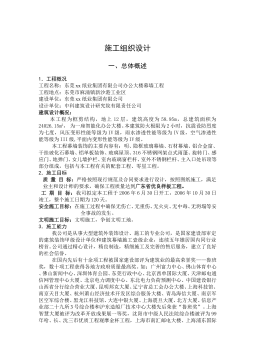
 2025-01-09 6
2025-01-09 6 -
建筑商品砼生产项目创业计划书VIP免费
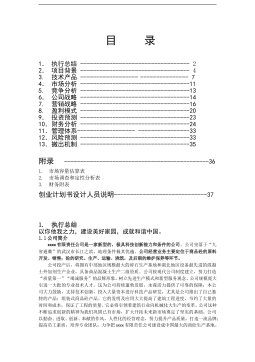
 2025-01-09 10
2025-01-09 10 -
建筑工程商业计划书模板VIP免费
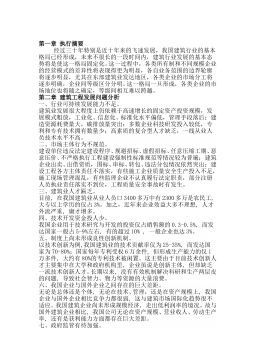
 2025-01-09 8
2025-01-09 8 -
工程项目施工计划书VIP免费

 2025-01-09 6
2025-01-09 6 -
《专业型文档》建筑企业计划书VIP免费
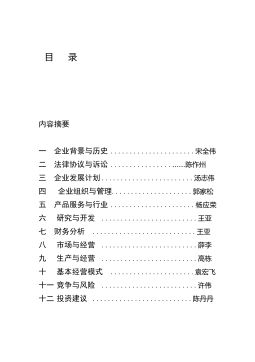
 2025-01-09 8
2025-01-09 8 -
xx水库灌区管道工程水工图纸C1VIP免费

 2025-01-09 13
2025-01-09 13 -
邮政区域仓储配送中心VIP免费

 2025-01-09 8
2025-01-09 8 -
疾病预防控制中心招标文件VIP免费
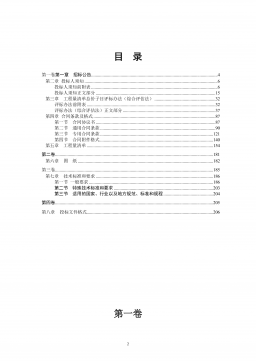
 2025-01-09 13
2025-01-09 13 -
体育健身中心施工招标文件VIP免费
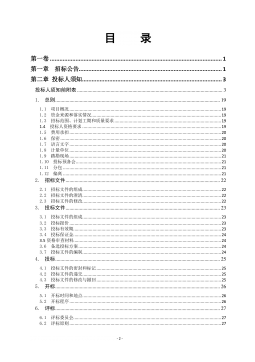
 2025-01-09 10
2025-01-09 10
作者:周伟光
分类:高等教育资料
价格:15积分
属性:72 页
大小:606.01KB
格式:PDF
时间:2024-09-29






